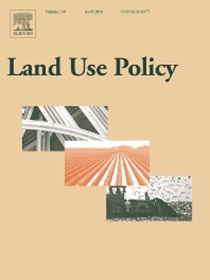伊朗北部跨越海拔梯度的农林业系统
IF 5.9
1区 社会学
Q1 ENVIRONMENTAL STUDIES
引用次数: 0
摘要
农林复合系统通过促进生物多样性和优化资源利用,可以增强生态系统服务,缓解从低地到高海拔地区不同海拔地带的环境挑战。通过考察农林业在不同海拔梯度中的作用,本文旨在强调农林业系统在解决不同海拔地区农民面临的挑战和机遇方面的潜力。为了实现这一目标,hycanian地区的两个省被选中:Mazandaran (Kalardasht县),代表半湿润的高地,Guilan (Rasht县),代表湿润的低地。本研究分两部分进行:社会经济评价和生物学评价。共完成了116份问卷,其中56份来自高地地区,60份来自低地地区。为了分析和比较生物多样性,计算了丰富度(Taxa_S)、多样性(Shannon_H)和公平性(Equitability_J)等指标。结果表明,低洼地区约有93% %和高地地区约有69% %的农民参与农林业活动。旱地最常见的树种是杨树(47 %),其次是核桃和桃树(均为11.7 %)。其他种类,如酸樱桃和松树,就不太常见了。在低地,杨树也是最常见的树种(65.5 %),其次是核桃(14.7 %)和橙(8.2 %)。结果表明:低海拔地区的密度(66 ± 74株/公顷)低于高海拔地区(403 ± 127株/公顷);低洼地的分类群指数(1.5 ± 0.18)低于高地(3.46 ± 0.38),物种多样性低于高地。不同高程地区森林特征的变化也对农林业和保护策略具有重要意义。在树木量和基材面积较高的低地地区,农林业系统可以设计成最大限度地提高树木生产力,从而可能提供更大的碳固存效益。然而,在高地地区,努力可能侧重于提高树木密度和物种多样性,以补偿较慢的生长速度和减少的生物量。此外,通过有针对性的保护和土地利用实践来管理这些差异对于维持不同海拔梯度的生物多样性和生态系统服务至关重要本文章由计算机程序翻译,如有差异,请以英文原文为准。
Agroforestry systems across elevational gradients in northern Iran
Agroforestry systems, by promoting biodiversity and optimizing resource use, can enhance ecosystem services and mitigate environmental challenges across different elevation zones, from lowlands to high-altitude regions. By examining the role of agroforestry across elevational gradients, this paper seeks to highlight the potential of agroforestry systems in addressing the challenges and opportunities faced by farmers in different altitude zones. To achieve this, two provinces within the Hyrcanian region were selected: Mazandaran (Kalardasht County), representing the semi-humid highlands, and Guilan (Rasht County), representing the humid lowlands. This study was conducted in two sections: socio-economic and biological evaluation. 116 questionnaires were completed, with 56 from the uplands and 60 from the lowland regions. To analyze and compare biodiversity, indices such as richness (Taxa_S), diversity (Shannon_H), and equitability (Equitability_J) were calculated. Results shows that about 93 % and 69 % of farmers were involved in agroforestry activities in lowlands and uplands, respectively. In upland area, the most commonly planted species is poplar (47 %), followed by walnut and peach (both 11.7 %). Other species, such as sour cherry and pine, are less common. In lowlands, poplar is also the most prevalent species (65.5 %), followed by walnut (14.7 %) and orange (8.2 %). The results showed that the density in lowlands (66 ± 74 trees per hectare) was lower than in uplands (403 ± 127 trees per hectare). The taxa index in lowland (1.5 ± 0.18) was lower than in upland (3.46 ± 0.38), suggesting a lower species diversity in Rasht compared to upland. The variation in forest characteristics across elevation zones also has important implications for agroforestry and conservation strategies. In lowland areas, where tree volume and basal area are higher, agroforestry systems can be designed to maximize tree productivity, potentially providing greater carbon sequestration benefits. In upland regions, however, efforts might focus on enhancing tree density and species diversity to compensate for slower growth rates and reduced biomass. Additionally, managing these differences through targeted conservation and land-use practices is crucial for sustaining biodiversity and ecosystem services across different altitudinal gradients
求助全文
通过发布文献求助,成功后即可免费获取论文全文。
去求助
来源期刊

Land Use Policy
ENVIRONMENTAL STUDIES-
CiteScore
13.70
自引率
8.50%
发文量
553
期刊介绍:
Land Use Policy is an international and interdisciplinary journal concerned with the social, economic, political, legal, physical and planning aspects of urban and rural land use.
Land Use Policy examines issues in geography, agriculture, forestry, irrigation, environmental conservation, housing, urban development and transport in both developed and developing countries through major refereed articles and shorter viewpoint pieces.
 求助内容:
求助内容: 应助结果提醒方式:
应助结果提醒方式:


